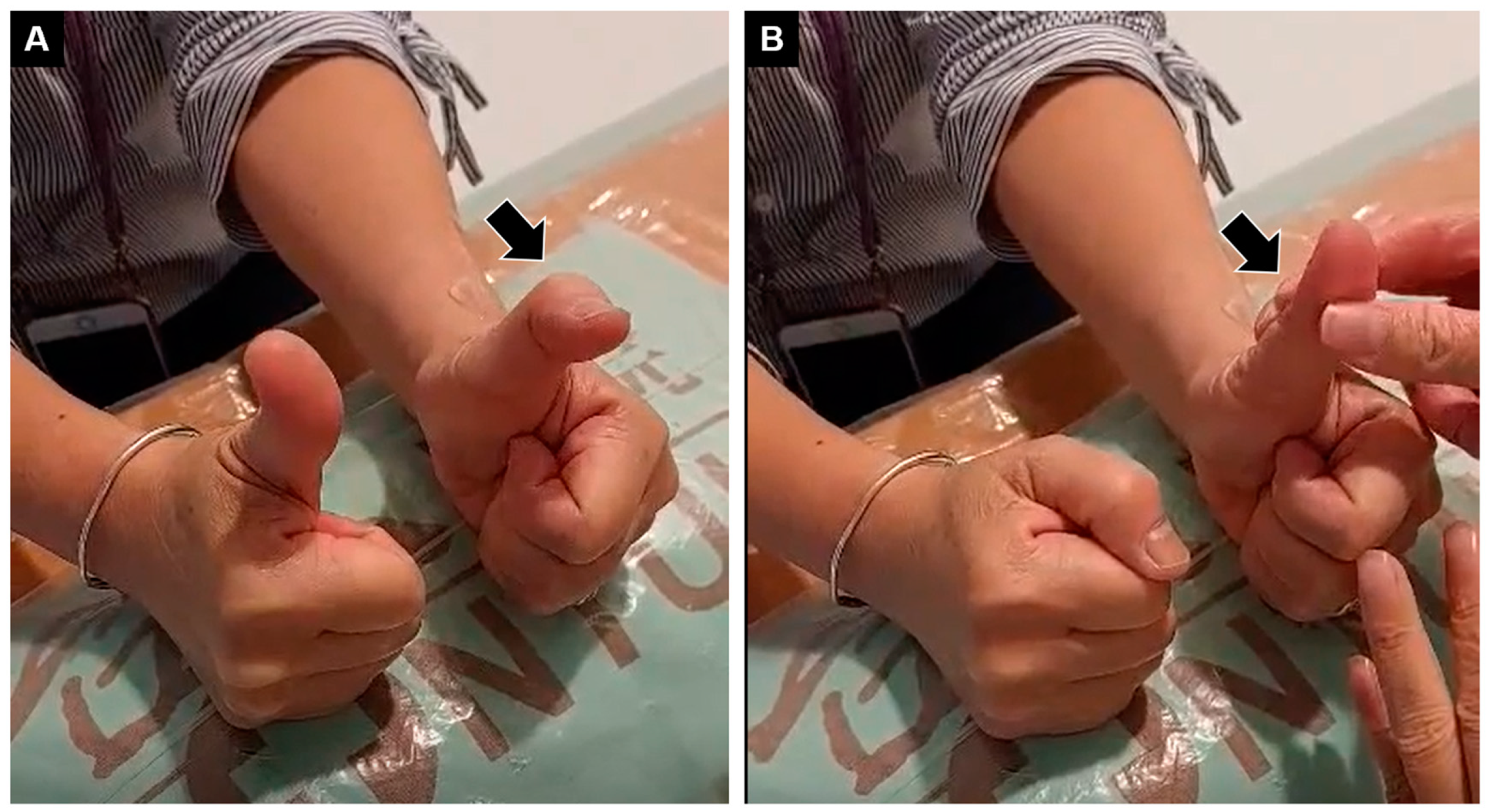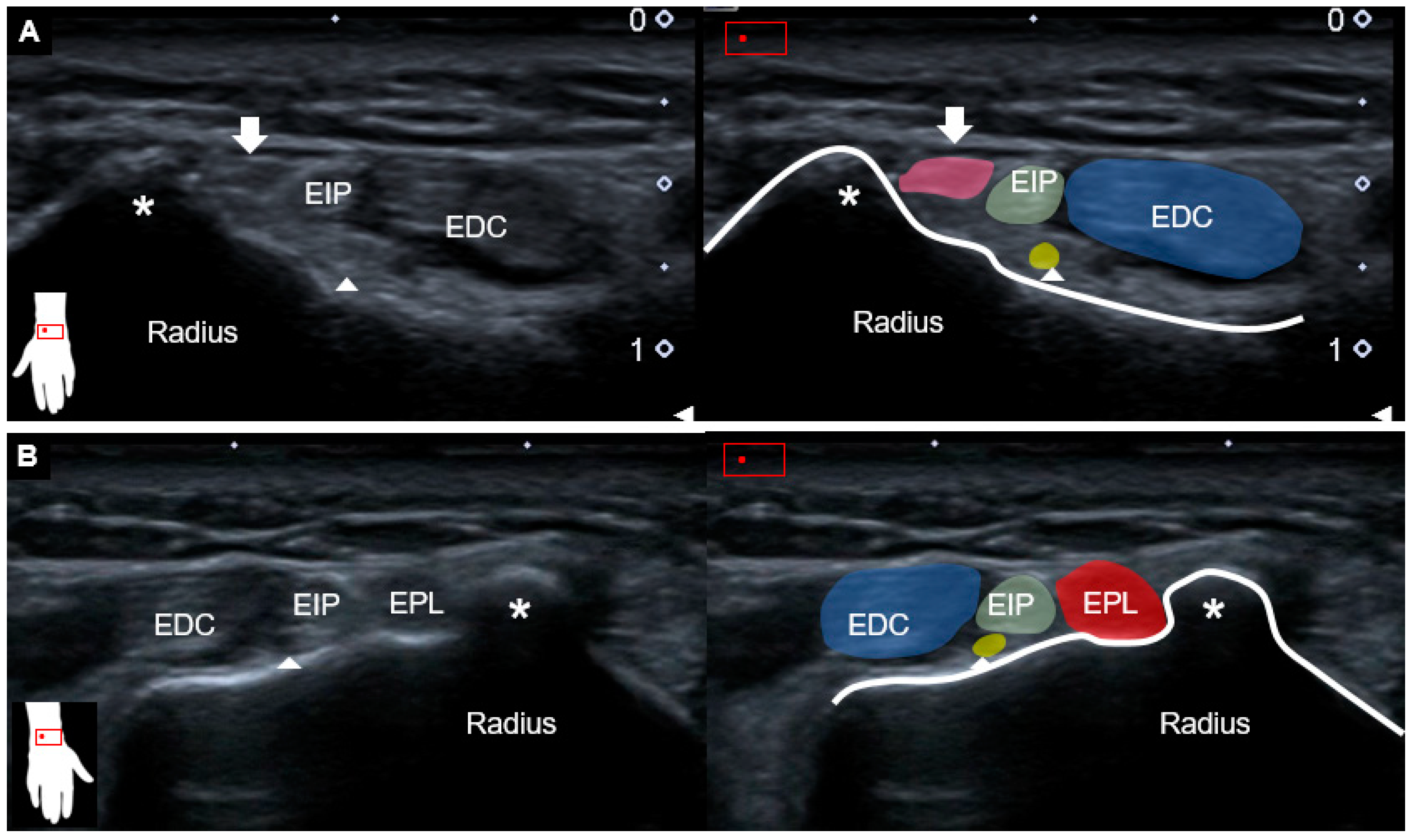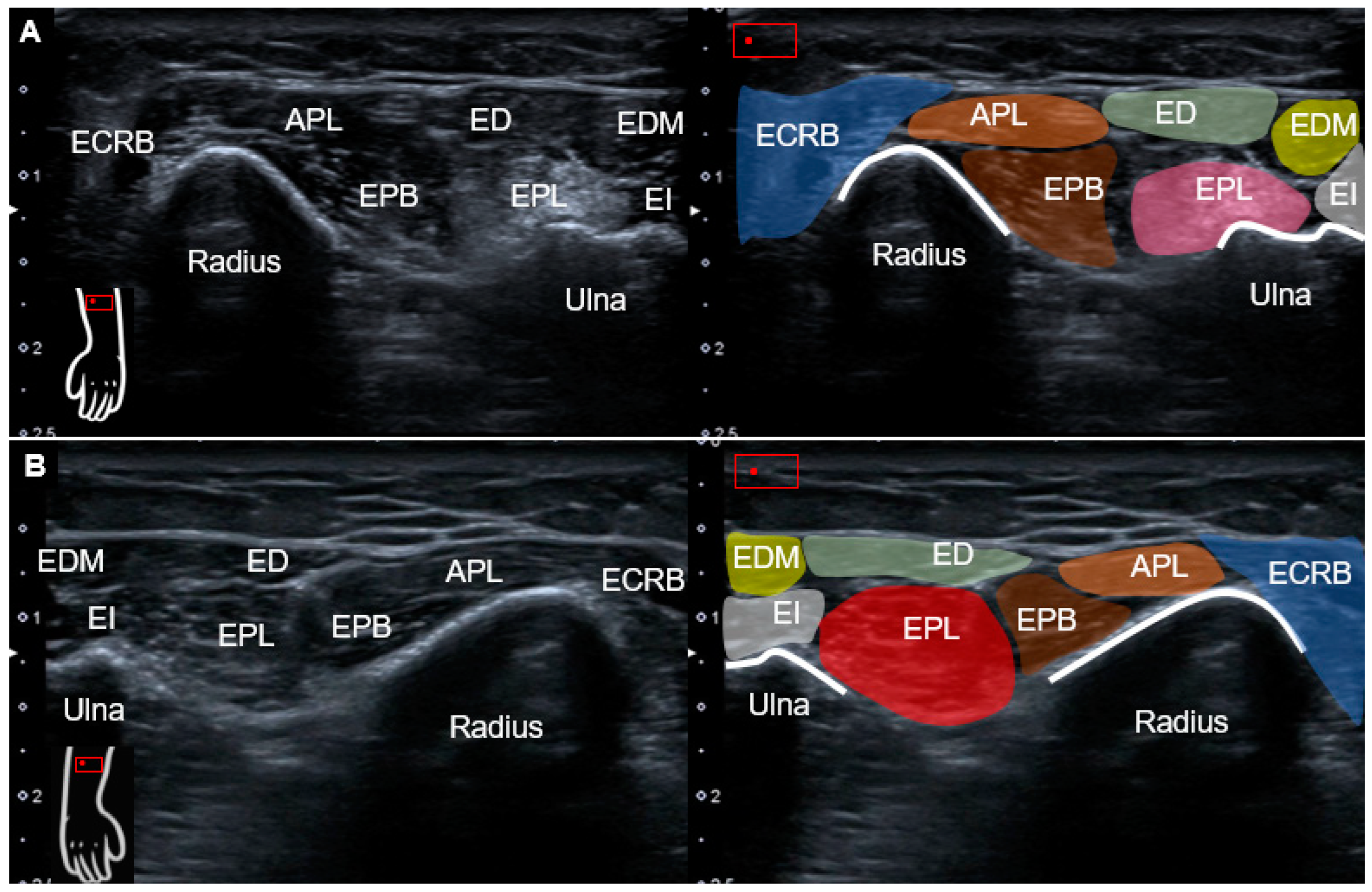Dynamic Ultrasound Examination for Extensor Pollicis Longus Tendon Rupture after Palpation-Guided Corticosteroid Injection
Abstract
:Supplementary Materials
Author Contributions
Funding
Institutional Review Board Statement
Informed Consent Statement
Data Availability Statement
Conflicts of Interest
References
- Wu, C.H.; Chang, K.V.; Özçakar, L.; Hsiao, M.Y.; Hung, C.Y.; Shyu, S.G.; Wang, T.G.; Chen, W.S. Sonographic tracking of the upper limb peripheral nerves: A pictorial essay and video demonstration. Am. J. Phys. Med. Rehabil. 2015, 94, 740–747. [Google Scholar] [CrossRef] [PubMed]
- Varatharaj, A.; Pinto, A.; Manning, M. Differential diagnosis of finger drop. Neurologist 2015, 19, 128–131. [Google Scholar] [CrossRef] [PubMed]
- Kudlac, M.; Cummings, R.; Finocchiaro, J. Finger Drop: Cervical Radiculopathy, Peripheral Nerve Lesion, or Multifocal Neuropathy? A Case Report. JOSPT Cases 2022, 2, 112–116. [Google Scholar]
- Horton, T. Isolated paralysis of the extensor pollicis longus muscle: A further variation of posterior interosseous nerve palsy. J. Hand Surg. 2000, 25, 225–226. [Google Scholar] [CrossRef] [PubMed]
- Lee, S.M.; Ha, D.H.; Han, S.H. Differential sonographic features of the extensor pollicis longus tendon rupture and other finger tendons rupture in the setting of hand and wrist trauma. PLoS ONE 2018, 13, e0205111. [Google Scholar] [CrossRef] [Green Version]
- De Maeseneer, M.; Marcelis, S.; Osteaux, M.; Jager, T.; Machiels, F.; Van Roy, P. Sonography of a rupture of the tendon of the extensor pollicis longus muscle: Initial clinical experience and correlation with findings at cadaveric dissection. Am. J. Roentgenol. 2005, 184, 175–179. [Google Scholar] [CrossRef]
- Björkman, A.; Jörgsholm, P. Rupture of the extensor pollicis longus tendon: A study of aetiological factors. Scand. J. Plast. Reconstr. Surg. Hand Surg. 2004, 38, 32–35. [Google Scholar] [CrossRef]
- Chen, S.-K.; Lu, C.-C.; Chou, P.-H.; Guo, L.-Y.; Wu, W.-L. Patellar tendon ruptures in weight lifters after local steroid injections. Arch. Orthop. Trauma Surg. 2009, 129, 369–372. [Google Scholar] [CrossRef] [PubMed]
- Lin, C.-Y.; Huang, S.-C.; Tzou, S.-J.; Yin, C.-H.; Chen, J.-S.; Chen, Y.-S.; Chang, S.-T. A Positive Correlation between Steroid Injections and Cuff Tendon Tears: A Cohort Study Using a Clinical Database. Int. J. Environ. Res. Public Health 2022, 19, 4520. [Google Scholar] [CrossRef]
- Newnham, D.; Douglas, J.; Legge, J.; Friend, J. Achilles tendon rupture: An underrated complication of corticosteroid treatment. Thorax 1991, 46, 853–854. [Google Scholar] [CrossRef] [PubMed] [Green Version]
- Smith, A.G.; Kosygan, K.; Williams, H.; Newman, R.J. Common extensor tendon rupture following corticosteroid injection for lateral tendinosis of the elbow. Br. J. Sport. Med. 1999, 33, 423–424. [Google Scholar] [CrossRef] [PubMed] [Green Version]
- Speed, C. Corticosteroid injections in tendon lesions. BMJ 2001, 323, 382–386. [Google Scholar] [CrossRef] [PubMed]
- Kapetanos, G. The effect of the local corticosteroids on the healing and biomechanical properties of the partially injured tendon. Clin. Orthop. Relat. Res. 1982, 163, 170–179. [Google Scholar] [CrossRef]
- Ketchum, L.D. Effects of triamcinolone on tendon healing and function: A laboratory study. Plast. Reconstr. Surg. 1971, 47, 471–482. [Google Scholar] [CrossRef] [PubMed]
- Lu, H.; Yang, H.; Shen, H.; Ye, G.; Lin, X.J. The clinical effect of tendon repair for tendon spontaneous rupture after corticosteroid injection in hands: A retrospective observational study. Medicine 2016, 95, e5145. [Google Scholar] [CrossRef] [PubMed]
- Chang, K.V.; Wu, W.T.; Han, D.S.; Özçakar, L. Static and Dynamic Shoulder Imaging to Predict Initial Effectiveness and Recurrence After Ultrasound-Guided Subacromial Corticosteroid Injections. Arch. Phys. Med. Rehabil. 2017, 98, 1984–1994. [Google Scholar] [CrossRef] [PubMed]
- Wang, J.C.; Chang, K.V.; Wu, W.T.; Han, D.S.; Özçakar, L. Ultrasound-Guided Standard vs Dual-Target Subacromial Corticosteroid Injections for Shoulder Impingement Syndrome: A Randomized Controlled Trial. Arch. Phys. Med. Rehabil. 2019, 100, 2119–2128. [Google Scholar] [CrossRef] [PubMed]
- Hsu, P.-C.; Chang, K.-V.; Wu, W.-T.; Wang, J.-C.; Özçakar, L. Effects of ultrasound-guided peritendinous and intrabursal corticosteroid injections on shoulder tendon elasticity: A post hoc analysis of a randomized controlled trial. Arch. Phys. Med. Rehabil. 2021, 102, 905–913. [Google Scholar] [CrossRef] [PubMed]
- Jeyapalan, K.; Choudhary, S. Ultrasound-guided injection of triamcinolone and bupivacaine in the management of de Quervain’s disease. Skelet. Radiol. 2009, 38, 1099–1103. [Google Scholar] [CrossRef] [PubMed]
- Yiannakopoulos, C.K.; Megaloikonomos, P.D.; Foufa, K.; Gliatis, J. Ultrasound-guided versus palpation-guided corticosteroid injections for tendinosis of the long head of the biceps: A randomized comparative study. Skelet. Radiol. 2020, 49, 585–591. [Google Scholar] [CrossRef] [PubMed]



Disclaimer/Publisher’s Note: The statements, opinions and data contained in all publications are solely those of the individual author(s) and contributor(s) and not of MDPI and/or the editor(s). MDPI and/or the editor(s) disclaim responsibility for any injury to people or property resulting from any ideas, methods, instructions or products referred to in the content. |
© 2023 by the authors. Licensee MDPI, Basel, Switzerland. This article is an open access article distributed under the terms and conditions of the Creative Commons Attribution (CC BY) license (https://creativecommons.org/licenses/by/4.0/).
Share and Cite
Chen, Y.-C.; Wu, W.-T.; Mezian, K.; Ricci, V.; Özçakar, L.; Chang, K.-V. Dynamic Ultrasound Examination for Extensor Pollicis Longus Tendon Rupture after Palpation-Guided Corticosteroid Injection. Diagnostics 2023, 13, 959. https://doi.org/10.3390/diagnostics13050959
Chen Y-C, Wu W-T, Mezian K, Ricci V, Özçakar L, Chang K-V. Dynamic Ultrasound Examination for Extensor Pollicis Longus Tendon Rupture after Palpation-Guided Corticosteroid Injection. Diagnostics. 2023; 13(5):959. https://doi.org/10.3390/diagnostics13050959
Chicago/Turabian StyleChen, Ying-Chun, Wei-Ting Wu, Kamal Mezian, Vincenzo Ricci, Levent Özçakar, and Ke-Vin Chang. 2023. "Dynamic Ultrasound Examination for Extensor Pollicis Longus Tendon Rupture after Palpation-Guided Corticosteroid Injection" Diagnostics 13, no. 5: 959. https://doi.org/10.3390/diagnostics13050959
APA StyleChen, Y.-C., Wu, W.-T., Mezian, K., Ricci, V., Özçakar, L., & Chang, K.-V. (2023). Dynamic Ultrasound Examination for Extensor Pollicis Longus Tendon Rupture after Palpation-Guided Corticosteroid Injection. Diagnostics, 13(5), 959. https://doi.org/10.3390/diagnostics13050959






